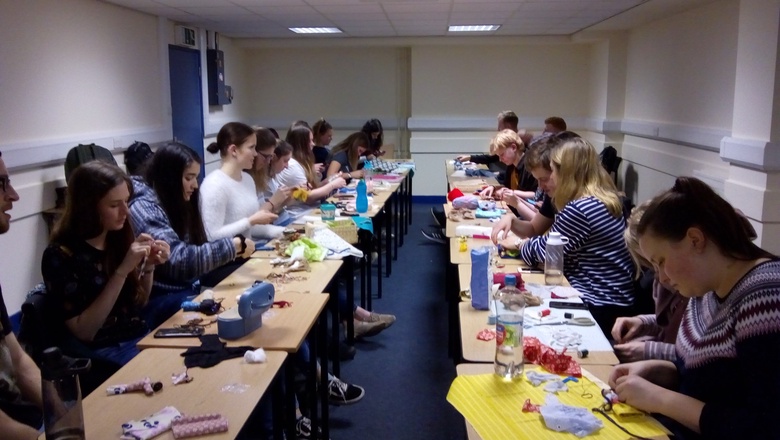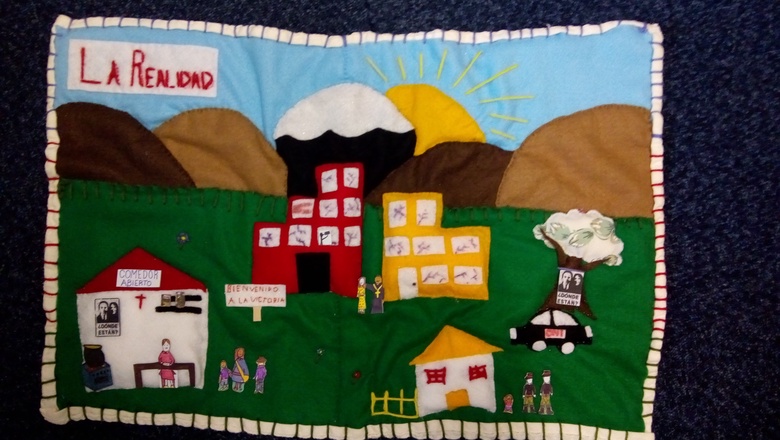
What did you do?
I assess honours students in my women’s history class by asking them to make a research-based arpillera, a Chilean fabric mural, and write a commentary about the process. Arpilleras emerged as an art form during the dictatorship of Augusto Pinochet (1973-1990) and usually depict scenes of everyday life, especially for those who were against the dictatorship or perceived to be leftist.
Why did you do it?
I wanted to encourage my students to think about the lives of Chilean women by creating a local art form, so that they could ‘learn by doing’. I thought that this experiential assessment would appeal to a wide-variety of learning types and offer students a new way to engage with the material.
How did you develop the idea?
I came across the idea at Queen’s University Belfast, where my colleague Dr Fiona Clark has used arpilleras for assessment previously. My colleague Dr Sandra Clark, who worked here and had worked at Queen’s, knew about Fiona’s assessment and we chatted about how it came about. The first step was training, and thus Sandra and I organised a workshop about the history of arpilleras and how to make them, bringing arpillera expert, Roberta Bacic, to Aberdeen to teach students and the wider public how to make arpilleras (Roberta’s work on arpilleras can be found here: https://cain.ulster.ac.uk/conflicttextiles/ and she worked with Fiona in Belfast, too).
That workshop provided me with enough training to start leading my own workshops on arpillera making. I build the workshop into class time and, having discussed the art form and shown students examples, we make an arpillera figure, using materials that I provide. Students are ingenious in figuring out how the make the rest of the mural themselves. They also submit a 1,000-word research reflection, discussing the process and the research behind their arpillera. This reflection is an important part of the assessment, as it allows me to assess students on their process, research, engagement with the form and concepts, rather than solely their skill with needle and thread.
What were the challenges?
Not all students have sewing or craft-making skills, so I also teach entry-level sewing skills.
What were the benefits to you?
It’s wonderful to see the students expressing their creativity and enjoying an intellectual challenge that has manual skills built in. The figure-making workshop is a great experience of learning together. Seeing the finished arpilleras is always amazing. The students do incredible work.
What was the impact on student learning?
Students understand aspects of recent Chilean history in an experiential way, which they could not get without the arpilleras. The arpilleras also build a strong sense of community amongst the students.
How did your students evaluate the experience?
The arpilleras draw students to the course, as they enjoy trying something new. The experiential aspect got them into the historical issues with ‘head, heart and hands’. On SCEF forms students said:

‘The arpillera assignment is a great break from the usual essays we have for other classes, and creativity has been encouraged this semester’.
‘Furthermore, the assignments for the course were also very enjoyable and did not feel too overwhelming as other courses from this year’.
‘Also, the arpilleras will be amazing, I’m sure!’
What did your students say?
Students told me that the assessment was something the discussed with family and friends, allowing a different type of engagement with the topic, it was something that they felt emotionally involved in and one student said that all of the students would remember making the arpilleras for the rest of their lives.
Charlotte Golly: ‘I really enjoyed the arpillera as an assessment because I felt that I engaged a lot more with _Schelling_rotate.jpg)
Neil Matheson: ‘I found the entire experience lovely. I thought the way the assessment was done was brilliant. I believe that too much of university is tested through written assessment, and this was a good opportunity for those who aren't so adept at essay writing’.
Hints/tips:
I never thought that the arpilleras would be approved as an assessment method, but they were. That was a good reminder for me not to reject my own ideas, but to ask.
Additional information:
The arpilleras will be on display in the library, ground floor exhibition space, this autumn.
For further information contact:
Professor Patience Schell p.schell@abdn.ac.uk
